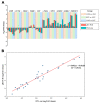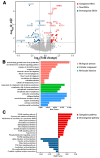Morphological Characteristics and Transcriptome Landscapes of Chicken Follicles during Selective Development
- PMID: 35327110
- PMCID: PMC8944860
- DOI: 10.3390/ani12060713
Morphological Characteristics and Transcriptome Landscapes of Chicken Follicles during Selective Development
Abstract
Ovarian follicle selection largely depends on the transition of granulosa cells from an undifferentiated to a fully differentiated state, which is accompanied by morphological and functional changes in follicles. The processes and transcriptional regulation of follicles during follicle selection are unclear; we thus used follicles from the prehierarchal to the hierarchal stage to investigate histology, reproductive endocrinology, and transcription. The morphology of follicles changed markedly during follicle selection. The numbers of large white, small yellow, and large yellow follicles (LWF, SYF, and LYF, respectively) were 11.83 ± 2.79, 6.83 ± 2.23, and 1.00, respectively, per ovary. LYF showed thicker granulosa cell layers than those of other prehierarchal follicles. Progesterone concentrations were significantly higher in LYF than that in LWF and SYF. In total, 16,823 genes were positively expressed in LWF, SYF, and LYF. Among follicle types, 1290 differentially expressed genes were enriched regarding cell differentiation, blood vessel morphogenesis, and response to steroid hormones. Candidate genes associated with follicle selection participated in the Wnt signaling pathway, steroid hormone biosynthesis, and the TGF-β signaling pathway. We produced insights into crucial morphological characteristics of transcriptional regulation in follicle development. Our results provide an important basis for revealing the mechanism of follicle selection and potential impact on the poultry industry.
Keywords: chicken; follicle selection; granulosa cells; morphological characteristics; transcriptome sequencing.
Conflict of interest statement
The authors declare no conflict of interest.
Figures










Similar articles
-
Transcriptome Analysis of Ovarian Follicles Reveals Potential Pivotal Genes Associated With Increased and Decreased Rates of Chicken Egg Production.Front Genet. 2021 Mar 10;12:622751. doi: 10.3389/fgene.2021.622751. eCollection 2021. Front Genet. 2021. PMID: 33777097 Free PMC article.
-
Transcriptome comparative analysis of ovarian follicles reveals the key genes and signaling pathways implicated in hen egg production.BMC Genomics. 2021 Dec 15;22(1):899. doi: 10.1186/s12864-021-08213-w. BMC Genomics. 2021. PMID: 34911438 Free PMC article.
-
Integrated transcriptomic analysis on small yellow follicles reveals that sosondowah ankyrin repeat domain family member A inhibits chicken follicle selection.Anim Biosci. 2021 Aug;34(8):1290-1302. doi: 10.5713/ajas.20.0404. Epub 2020 Oct 13. Anim Biosci. 2021. PMID: 33152230 Free PMC article.
-
Dynamics of avian ovarian follicle development: cellular mechanisms of granulosa cell differentiation.Gen Comp Endocrinol. 2009 Sep 1;163(1-2):12-7. doi: 10.1016/j.ygcen.2008.11.012. Epub 2008 Nov 27. Gen Comp Endocrinol. 2009. PMID: 19059411 Review.
-
Ovarian follicle selection and granulosa cell differentiation.Poult Sci. 2015 Apr;94(4):781-5. doi: 10.3382/ps/peu008. Epub 2014 Dec 22. Poult Sci. 2015. PMID: 25535403 Review.
Cited by
-
Regulation of Follicular Development in Chickens: WIF1 Modulates Granulosa Cell Proliferation and Progesterone Synthesis via Wnt/β-Catenin Signaling Pathway.Int J Mol Sci. 2024 Feb 1;25(3):1788. doi: 10.3390/ijms25031788. Int J Mol Sci. 2024. PMID: 38339068 Free PMC article.
-
Untargeted Metabolomics Revealed Potential Biomarkers of Small Yellow Follicles of Chickens during Sexual Maturation.Metabolites. 2023 Jan 26;13(2):176. doi: 10.3390/metabo13020176. Metabolites. 2023. PMID: 36837802 Free PMC article.
-
Effects of dietary calcium source and quantity on the laying rate, eggshell quality, reproductive tract, liver fat level, and duodenum morphology in Dekalb white laying hens of 90 weeks of age.Poult Sci. 2025 Jun 16;104(9):105446. doi: 10.1016/j.psj.2025.105446. Online ahead of print. Poult Sci. 2025. PMID: 40544675 Free PMC article.
-
Transcriptomic data reveals MYC as an upstream regulator in laying hen follicular recruitment.Poult Sci. 2025 Jan;104(1):104547. doi: 10.1016/j.psj.2024.104547. Epub 2024 Nov 13. Poult Sci. 2025. PMID: 39580902 Free PMC article.
-
miRNA profiling of chicken follicles during follicular development.Sci Rep. 2024 Jan 26;14(1):2212. doi: 10.1038/s41598-024-52716-x. Sci Rep. 2024. PMID: 38278859 Free PMC article.
References
Grants and funding
LinkOut - more resources
Full Text Sources

